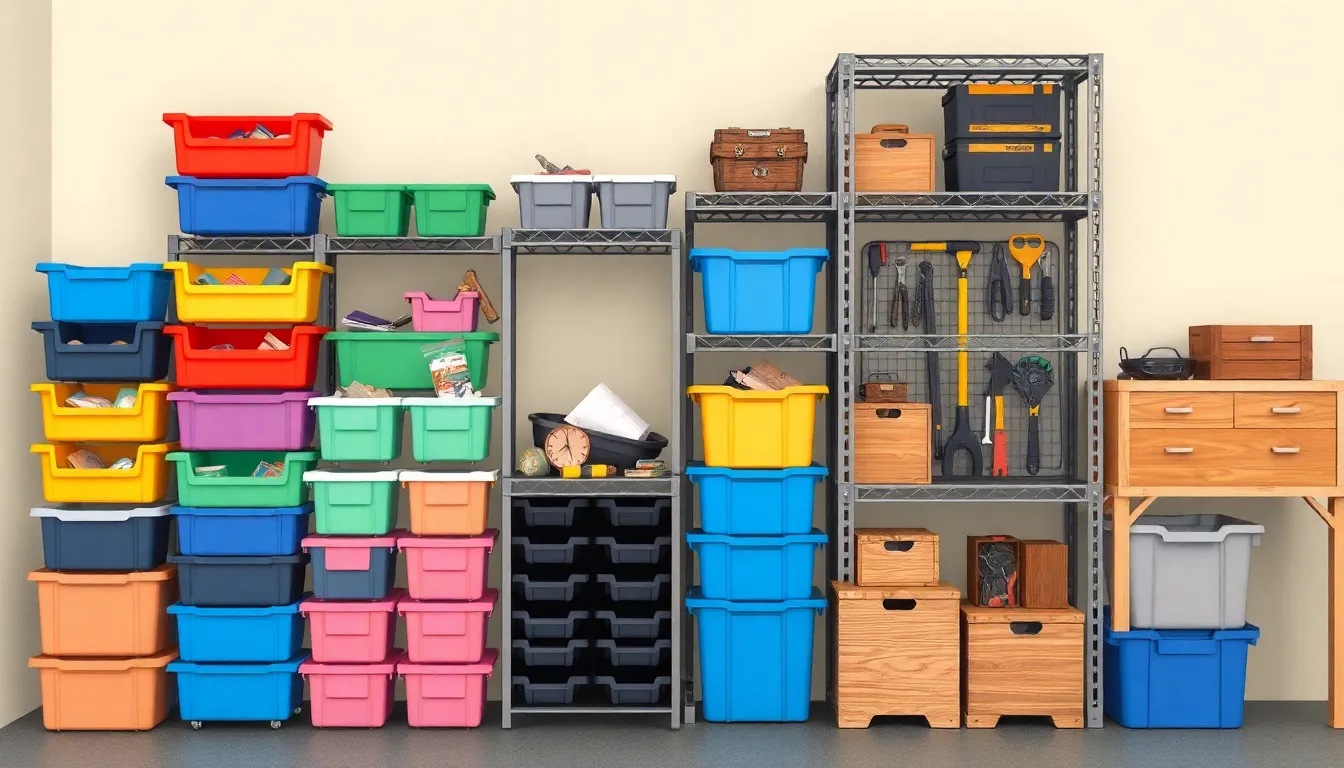In a world where clutter seems to multiply faster than rabbits, stackable storage is the superhero every home desperately needs. Imagine a life where your belongings don’t just sit there, taking up precious real estate but instead stand tall and proud, neatly organized and easily accessible. It’s like Tetris but for your stuff—who wouldn’t want to play that game?
Table of Contents
ToggleOverview of Stackable Storage
Stackable storage refers to modular systems designed to optimize storage space by stacking containers on top of one another. These systems help individuals utilize vertical space efficiently, making them ideal for small homes or tight areas. Various materials, such as plastic, metal, and wood, make up stackable storage options, catering to different aesthetic preferences and functional needs.
Homeowners can choose from a range of sizes and styles, ensuring that they find storage solutions that fit their spaces. Common types include bins, boxes, and shelves, which can be mixed and matched to create customized storage setups. Organizations can benefit from stackable storage units, enhancing inventory management by reducing floor space and improving accessibility to products.
It’s essential to consider weight limits when stacking storage units to ensure safety and stability. Stackable storage units often include features like locking mechanisms, which secure items in place and prevent accidents. Users should also think about their specific storage needs, as some options offer transparency for easy visibility of contents.
The versatility of stackable storage makes it perfect for various applications, from home organization to office supplies and garage clutter. Integration of these systems into daily life can lead to more organized and functional living spaces. Choosing stackable storage not only alleviates clutter but also promotes a more sustainable lifestyle by maximizing available resources.
Types of Stackable Storage

Various types of stackable storage options cater to different needs and preferences. Below are some popular categories of these storage solutions.
Plastic Stackable Bins
Plastic stackable bins offer a lightweight and durable option for organizing items. These bins come in various sizes and colors, allowing customization for different spaces. Many bins feature clear design, providing visibility of contents. Lids often come with a snug fit, helping to protect against dust. Stackable features maximize vertical space, making them especially useful in closets or garages. Homeowners appreciate the ease of cleaning and maintenance, as plastic bins can simply be wiped down. These containers work well for storing toys, craft supplies, or kitchen items.
Metal Stackable Racks
Metal stackable racks provide sturdy, long-lasting storage for heavy-duty items. Constructed from materials like steel, these racks can support significant weight. Ideal for garages and workshops, they maintain stability under pressure. Many designs include adjustable shelves, accommodating various sizes of tools or equipment. The open structure allows for better air circulation, reducing the risk of moisture buildup. Users often find that metal racks enhance organization while maximizing floor space. They can efficiently hold bins, boxes, and other supplies to create a streamlined setup.
Wooden Stackable Boxes
Wooden stackable boxes bring a touch of warmth and elegance to any space. These boxes come in multiple finishes, adding aesthetic appeal to both home and office environments. Strong construction ensures durability, making them suitable for heavier items. Many designs include features like dividers for easy categorization of contents. Stackable options optimize vertical space while providing a stylish storage solution. Users love that these wooden boxes blend functionality with visual charm. Perfect for books, decorative items, or craft materials, they enhance organization while complementing decor.
Benefits of Using Stackable Storage
Stackable storage offers several advantages that enhance efficiency and organization in various spaces. Significant benefits include space efficiency and organizational flexibility.
Space Efficiency
Space efficiency remains a primary benefit of stackable storage systems. By utilizing vertical space, these containers create additional room on the floor. Homeowners can stack bins or boxes, maximizing storage capacity without occupying more square footage. Many options accommodate various sizes, enabling optimal use in tight spots. For example, layers of bins in closets or garages provide easy access without clutter. This innovative approach helps individuals manage limited areas more effectively.
Organizational Flexibility
Organizational flexibility enhances the versatility of stackable storage solutions. Users can adapt these systems to fit diverse needs and preferences. Configurable arrangements allow for customization based on items stored. Different sizes and styles cater to specific categories, from office supplies to seasonal decorations. Modular designs make it simple to reconfigure as storage needs change. Consequently, homeowners enjoy manageable organization tailored to their lifestyle. Businesses also benefit by effectively managing inventory with adaptable units, improving overall efficiency.
Tips for Choosing the Right Stackable Storage
Selecting the appropriate stackable storage involves understanding both space limitations and personal needs. These factors significantly influence the effectiveness of the chosen system.
Consider Your Space
Evaluate your available space before making a decision. Measure dimensions to determine the height and width where storage units will reside. This step ensures that the chosen stackable storage fits seamlessly into the intended area. Look for height restrictions, particularly in closets or under shelves. Consider vertical space to maximize storage potential without crowding the room. Adequate floor space allows easier access to the units and maintains an orderly look. Compact units work well in tight areas, while larger structures offer more storage capacity but may require additional planning.
Assess Your Needs
Identify specific storage needs to guide your choice of stackable units. Various items may require different types of storage solutions, such as bins for seasonal clothes or boxes for toys. Consider the weight and quantity of items stored to select a durable material. For heavy items, opt for metal or reinforced plastic. Acknowledge whether accessibility is essential, especially for frequently used items, or if visibility is a priority for stored goods. Prioritize versatility, as some systems offer adjustable shelves or interchangeable bins, accommodating changing storage requirements over time.
Embracing stackable storage can significantly enhance both organization and efficiency in any space. By maximizing vertical areas and offering flexible configurations, these systems cater to diverse needs and preferences. Homeowners and businesses alike can benefit from the adaptability of stackable solutions, ensuring that every item has its place.
Choosing the right materials and designs is essential for achieving optimal results. With careful consideration of space and individual requirements, stackable storage can transform cluttered environments into orderly, functional areas. Ultimately, it’s about creating a sustainable lifestyle that values both accessibility and aesthetics.




